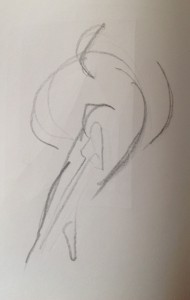 The essence of “gesture drawing” practice in its original form (figure drawing from life) is to feel the movement (or posture) of a figure — feel it in your own body, and through it, the inner sensations and emotions. It is a very quick, two-four minutes, study — you use the intuition of your body, not the power of your mind. You don’t over-analyze it (nor, in fact, analyze it at all), but (kind of) connect with the figure in the painting on the level of bodily sensation, (almost) making the same movement — and capturing this movement with your hand, without even attempting any similarity between your drawing and the subject matter. Here is how a quick gesture drawing might look.
The essence of “gesture drawing” practice in its original form (figure drawing from life) is to feel the movement (or posture) of a figure — feel it in your own body, and through it, the inner sensations and emotions. It is a very quick, two-four minutes, study — you use the intuition of your body, not the power of your mind. You don’t over-analyze it (nor, in fact, analyze it at all), but (kind of) connect with the figure in the painting on the level of bodily sensation, (almost) making the same movement — and capturing this movement with your hand, without even attempting any similarity between your drawing and the subject matter. Here is how a quick gesture drawing might look.
How does it apply to studying a painting? After all, the painting is still, right? It already captures a single moment, not a movement. But that’s not quite the case — the moment is captured, but it is — as a rule — not static; in a master painting, we still feel the movement, and that’s what you will be trying to capture here. Or, if there is no movement — if there is really a moment of stillness, you can feel it in your body, too. A woman sitting in silent reverie, weighted down by her thoughts — and a woman captured in the midst of a joyful movement — these are two quite different paintings…
But what if there are no people in the painting you are studying? Does it really mean there are no gestures — no movement visible in the painting? In a sense, this might be the only drawing practice that’s easier to do with a human figure — because it’s easier for us to empathize with a human, to feel their body as “our own”, to put ourselves in their shoes. It’s more difficult to connect with a tree, or an apple, or a cloud — to be, for a moment, one with that tree, that apple, that cloud — but that, in a sense, is what the painter does, being completely “as one” with the visible reality, dissolving the duality between “subjective” and “objective”. So — if at all possible — try to do a few gesture studies even if you are studying a still life or a landscape. Once again, don’t overanalyze it, just try to feel a movement and capture it in your two-four minutes “study”.
This study not only allows you to connect with the painting at a deeper level, but there is another benefit. If you feel the movement in the painting, that means that the artist expressed this movement in some way — you don’t yet know how (we will come to it later), but this practice will help you be more aware of what is expressed, using not the thought processes in your head, but the whole mind-body (head-heart-hand) system that is “you”…
These studies are to be done on large newsprint paper, using the whole range of your arm. You can use very soft pencils, charcoal, or paint and brush, whichever you prefer. Do several such studies, witnessing the differences and similarities — which one captures best the essence of what is expressed in the painting? It makes sense to “record” some of these observations in your sketchbook, too.